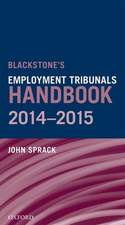The Media, the Court, and the Misrepresentation: The New Myth of the Court: Law, Courts and Politics
Autor Rorie Spill Solberg, Eric N. Waltenburgen Limba Engleză Paperback – 2 dec 2014
This book uncovers and describes this coverage and compares it to the confirmation hearings, the Court’s actual work, even its members. Rorie Spill Solberg and Eric N. Waltenburg analyze media coverage of nominations and confirmation hearings, the justices’ "extra-curricular" activities and their retirements/deaths, and the Court’s opinions, and compare this coverage to analyses of confirmation transcripts and the Court’s full docket. Solberg and Waltenburg contend that media now cover the Court and its personnel more similarly to its coverage of other political institutions. Journalists still regurgitate a mythology supported by the justices, a "cult of the robe," wherein unbiased and apolitical judges mechanically base their decisions upon the law and the Constitution. Furthermore, they argue the media also focus on the "cult of personality," wherein the media emphasize certain attributes of the justices and their work to match the public’s preferences for subject matter and content. The media’s portrayal, then, may undercut the Court’s legitimacy and its reservoir of good will.
| Toate formatele și edițiile | Preț | Express |
|---|---|---|
| Paperback (1) | 438.86 lei 6-8 săpt. | |
| Taylor & Francis – 2 dec 2014 | 438.86 lei 6-8 săpt. | |
| Hardback (1) | 995.54 lei 6-8 săpt. | |
| Taylor & Francis – 4 dec 2014 | 995.54 lei 6-8 săpt. |
Preț: 438.86 lei
Nou
Puncte Express: 658
Preț estimativ în valută:
84.00€ • 91.28$ • 70.61£
84.00€ • 91.28$ • 70.61£
Carte tipărită la comandă
Livrare economică 21 aprilie-05 mai
Preluare comenzi: 021 569.72.76
Specificații
ISBN-13: 9781138831230
ISBN-10: 1138831239
Pagini: 132
Ilustrații: 15 black & white tables, 26 black & white line drawings
Dimensiuni: 152 x 229 x 10 mm
Greutate: 0.2 kg
Ediția:1
Editura: Taylor & Francis
Colecția Routledge
Seria Law, Courts and Politics
Locul publicării:Oxford, United Kingdom
ISBN-10: 1138831239
Pagini: 132
Ilustrații: 15 black & white tables, 26 black & white line drawings
Dimensiuni: 152 x 229 x 10 mm
Greutate: 0.2 kg
Ediția:1
Editura: Taylor & Francis
Colecția Routledge
Seria Law, Courts and Politics
Locul publicării:Oxford, United Kingdom
Public țintă
Postgraduate and UndergraduateCuprins
1. Introduction: The Myths of the Court 2. Confirmation and the "Cult of Personality" 3. The Decisional Myth 4. The Decisional Myth, Part 2 – The Landmark Cases 5. The Personal Myth 6. Conclusion: Processing the Myths of the Court
Recenzii
"Through extensive analysis of media coverage of the Court and its justices, Rorie Spill Solberg and Eric N. Waltenburg explain how journalists increasingly emphasize the personalities of individual justices rather than just ‘the cult of the robe.’ This ‘cult of personality’ emerges not only through profiles of the justices but also in docket coverage and reporting on the confirmation process. This book is a must-read for scholars of the Court as well as everyone concerned about public perception of the Court and its impact on the Court’s role as an arbiter in American politics and society."—Richard Davis, Brigham Young University
"Solberg and Waltenburg's provocative study documents increasing media attention to personalities and politics in Supreme Court coverage, creating critical disconnects between objective reality and its media portrayal. Whether reporting on confirmation hearings, the Court's docket, its landmark cases or the justices themselves, such media portrayal increasingly mimics that of the patently political co-equal branches with potentially damaging consequences for public understanding of the Court and acceptance of its work." —Elliot E. Slotnick, The Ohio State University
"Solberg and Waltenburg's book on media coverage of the Supreme Court is the most comprehensive analysis to date. It covers confirmation hearings, the decisions, and the individuals on the Court in a careful and thoroughly engaging way, and convincingly reveals how media coverage affects public understandings (and misunderstandings) about the Supreme Court."—Valerie Hoekstra, Arizona State University
"Solberg (public policy, Oregon State) and Waltenburg (Purdue Univ.) examine media coverage of the US Supreme Court to ascertain the degree to which the old myth of the “cult of the robe,” which stresses judicial objectivity, competes with the new myth of the “cult of personality.” Using complex analyses of media coverage in leading outlets, the authors find that they increasingly stress personal and political differences among justices. ... The authors fear that media emphasis on judicial personalities could undermine belief in the justices’ fairness but cannot prove that it has yet done so. More importantly, they do not report whether scholars, who long ago exploded the cult of the robe, have done better than the media in focusing on judicial reasoning rather than personalities or politics."
--J. R. Vile, Middle Tennessee State University
"Solberg and Waltenburg's provocative study documents increasing media attention to personalities and politics in Supreme Court coverage, creating critical disconnects between objective reality and its media portrayal. Whether reporting on confirmation hearings, the Court's docket, its landmark cases or the justices themselves, such media portrayal increasingly mimics that of the patently political co-equal branches with potentially damaging consequences for public understanding of the Court and acceptance of its work." —Elliot E. Slotnick, The Ohio State University
"Solberg and Waltenburg's book on media coverage of the Supreme Court is the most comprehensive analysis to date. It covers confirmation hearings, the decisions, and the individuals on the Court in a careful and thoroughly engaging way, and convincingly reveals how media coverage affects public understandings (and misunderstandings) about the Supreme Court."—Valerie Hoekstra, Arizona State University
"Solberg (public policy, Oregon State) and Waltenburg (Purdue Univ.) examine media coverage of the US Supreme Court to ascertain the degree to which the old myth of the “cult of the robe,” which stresses judicial objectivity, competes with the new myth of the “cult of personality.” Using complex analyses of media coverage in leading outlets, the authors find that they increasingly stress personal and political differences among justices. ... The authors fear that media emphasis on judicial personalities could undermine belief in the justices’ fairness but cannot prove that it has yet done so. More importantly, they do not report whether scholars, who long ago exploded the cult of the robe, have done better than the media in focusing on judicial reasoning rather than personalities or politics."
--J. R. Vile, Middle Tennessee State University
Descriere
This book uncovers and describes media coverage of the Supreme Court and compares it to the Court’s actual work, its members, and the confirmation hearings. Analyzing media coverage of nominations and confirmation hearings, the justices’ ‘extra-curricular’ activities and their retirements/deaths, and the Court’s opinions and comparing this coverage to analyses of confirmation transcripts and the Court’s full docket, Rorie Spill Solberg and Eric N. Waltenburg contend that media now cover the Court and its personnel more similarly to its coverage of other political institutions.
























